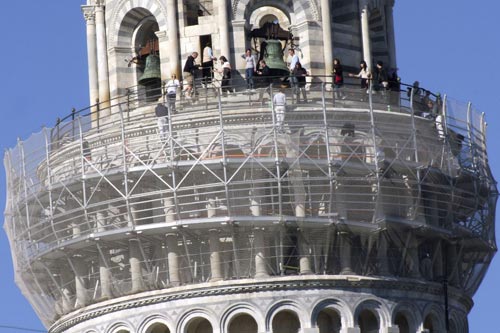Top News
Restorers put final touches on Leaning Tower of Pisa
Updated: 2010-12-15 08:04
By Ella Ide (China Daily)
PISA, Italy - As a biting wind howls through the Leaning Tower of Pisa, Marco Berettini pulls his hat down closer over his ears and struggles across the slanted belfry to shelter behind a medieval pillar.
Berettini is battling the elements to put the finishing touches to an eight-year restoration project to remove sea salt, pigeon droppings and tourist graffiti from the tower before the scaffolding comes down early next year.
 |
|
People walk on top of Pisa's leaning tower on Dec 2. The scaffolding is about to come off the Leaning Tower of Pisa following a painstaking two-year restoration that has restored the medieval masterpiece to its former glory. [Fabio Muzzi / Agence France-Presse] |
At just 12 km from the Mediterranean shores, the tower is frequently battered by storms coming off the coast. Its wide, open arches also provide scant shade for the restorers from blistering hot Tuscan summers.
"You have to be really passionate about wanting to save the tower, or you'd never be able to make yourself get up at dawn and spend all day leaning," said Berettini, 41.
"The conditions are extreme, and we often have to work in excessive temperatures. But it's a job you do for love," he boasted with a grin.
Armed with lasers, chisels and syringes, the 10-strong team has taken eight years and three months to clean the 24,424 blocks of stone that make up the 56-meter high tower, sometimes working well into the night.
"The stones were in an appalling state, mainly due to air pollution, though tourists and pigeons played a part," explained Anton Sutter, the Swiss-born head restorer, who attended art restoration school in Pisa 25 years ago.
The distinctive, yellowish stone came from the quarries of San Giuliano, visible from the top of the tower, which scar the green hills behind Pisa.
"The columns are decorated with capitals: Flowers, ghoulish faces, fantastical animals," Sutter said.
"But sea salt carried on the wind and rain water that collects in certain areas because of the tower's tilt have damaged many," Sutter said, explaining that the water could not drain properly because of the angle.
"We've taken out the concrete used in past restorations and cleaned up the pigeon dirt, graffiti and hand-prints left by tourists as they struggle to keep their balance while climbing the winding stairs to the top."
Legend has it the tower was begun in 1173 AD after a Pisan noblewoman left 60 coins to the city in her will to build a magnificent belfry.
But after just three levels had been built, the tower began to lean, sinking into its foundations on one side. Though panicked architects and engineers have been trying to stabilize it ever since, the tower has continued to tilt.
In 1987 it was declared a World Heritage Site by the United Nations' cultural organization UNESCO, but as fears grew that it would topple over it was closed to the public in 1990.
Agence France-Presse
E-paper

Ear We Go
China and the world set to embrace the merciful, peaceful year of rabbit
Preview of the coming issue
Carrefour finds the going tough in China
Maid to Order
Specials

Mysteries written in blood
Historical records and Caucasian features of locals suggest link with Roman Empire.

Winning Charm
Coastal Yantai banks on little things that matter to grow

New rules to hit property market
The State Council launched a new round of measures to rein in property prices.
